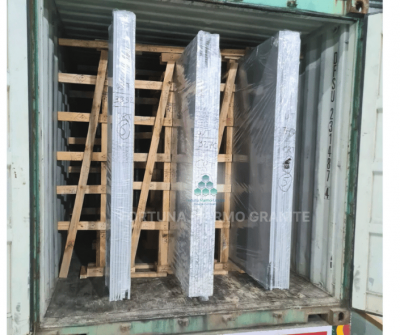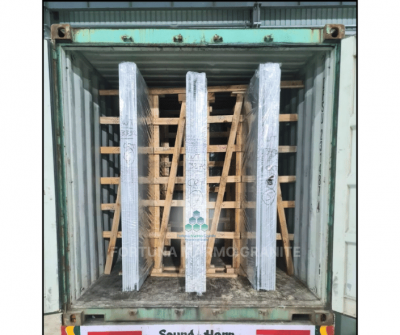Granite Slab Packing for Export – Ensuring Strength, Safety, and Sustainability
When it comes to exporting granite slabs across the globe, the journey begins long before the stone reaches the customer's doorstep—it starts with impeccable packing. Additionally, At Fortuna Marmo Granite, we understand that every slab is not just a product, but a reflection of natural beauty, craftsmanship, and quality. That's why our granite slab packing methods are engineered to meet the highest international standards. Moreover, We combine strength, safety, and sustainability to ensure that each slab arrives in perfect condition, no matter the distance it travels.
Yet, By optimizing space and minimizing environmental impact through eco-conscious materials, we not only protect the stone but also promote responsible export practices. Whether shipping to the USA, Europe, the Middle East, or Australia, our proven packing techniques have earned the trust of global buyers who rely on us for consistent, dependable, and damage-free deliveries. With Fortuna Marmo Granite, you get more than just a granite supplier—you get a packaging partner committed to excellence from quarry to container.


1 . Material Selection: The Foundation of Strength
Wooden Crates and Skids: These form the backbone of granite packing.
Hardwood (e.g., Oak, Sal, Neem): Manufacturers prefer hardwood for its strength and resistance to bowing or splintering. It can withstand immense loads.
Softwood (e.g., Pine, Spruce): This wood works well for lighter slabs or internal supports but usually needs reinforcement.
ISPM 15 Compliance: All wood packaging for international shipping must carry the ISPM 15 stamp. Heat treatment or fumigation makes the wood pest-free and safe for export.
- Steel Strapping: High-tensile steel bands are essential for securing slabs to skids and reinforcing crates. They provide immense compressive strength, preventing movement and ensuring the structural integrity of the package.
- Protective Padding:
- Styrofoam Sheets/Foam Boards: Used between slabs to absorb shocks, prevent scratching, and provide a cushioning effect.
- Corrugated Cardboard: Can be used for lighter protection or as interleaving material.
- Plastic Sheeting (Polyethylene): Acts as a moisture barrier, protecting the polished surface from humidity, rain, and condensation, which can lead to watermarks or hazing.
- Edge Protectors: Plastic or cardboard U-profiles fitted onto the edges of slabs to prevent chipping and impact damage, especially during handling.
2. Design and Construction: Engineering for Resilience
A-Frames (Bundles): Moreover, Use A-frames for multiple slabs of the same size. Position the slabs at an angle against a sturdy wooden frame. Secure them with steel straps. Gravity keeps the slabs snug against the frame, reducing movement. The base of the A-frame plays a vital role by providing stability and supporting the entire bundle.
Closed Crates: In addition, Choose fully enclosed wooden crates for individual, high-value, or fragile slabs. Match the crate's internal dimensions closely to the slab's size to avoid shifting. Add internal bracing and dunnage for extra protection.
Proper Blocking and Bracing: In addition, This step is the most critical for preventing movement. Place wooden blocks, wedges, and internal bracing strategically to fill voids and stop shifting in any direction. These elements also absorb shocks and effectively lock the slab in place.
Strap Tension and Placement: Apply steel straps with the right tension. Loose straps fail to secure the slab, while overly tight straps risk damaging the edges. Place straps strategically to distribute pressure evenly and prevent buckling. Always use corner protectors to stop straps from cutting into the granite.
3. The Packing Process: A Step-by-Step Approach
Inspection and Cleaning: Additionally, Inspect each slab for damage before packing. Clean it thoroughly to remove dust, debris, and oil. This prevents finish issues and future problems.
Edge Protection: Add plastic or cardboard protectors to all four edges of the slab.
Interleaving: Place foam, cardboard, or plastic sheets between slabs in a bundle or crate. This prevents surface abrasion.
Positioning on Skid/A-Frame: Place the slabs carefully on the prepared skid or A-frame. Distribute weight evenly to maintain balance.
Blocking and Bracing: Fix wooden blocks and braces to secure the slabs in place. Skilled handling is crucial to stop movement.
Strapping: In addition, Strap the slabs and wooden frame with high-tensile steel bands. Use strapping tools to apply proper tension. Add corner protectors under the straps.
6.Moisture Barrier: Wrap the entire package in heavy-duty plastic sheeting to protect against moisture.
7. Labeling and Marking: Clearly label the package with:
- Destination address
- Handling instructions (e.g., "Fragile," "This Side Up," "Do Not Drop")
- Gross and net weight
- Dimensions
- ISPM 15 mark (if applicable)
- Client order number and contents description
4. Loading and Securing for Transit: The Final Frontier
Specialized Equipment: Use forklifts or cranes with proper slings to lift granite safely. Choose equipment designed to handle the stone's immense weight.
Even Weight Distribution in Container: Moreover, Load containers with evenly distributed weight. This prevents tipping and keeps the shipment stable during transit.
Container Lashing and Dunnage: In addition, Lash and dunnage the packed slabs securely inside the container. Use airbags, wooden braces, and heavy-duty straps to fill voids and absorb shocks.
The Growing Emphasis on Sustainability in Packing
- Reusability: Additionally, Use sturdy packing solutions such as A-frames that can handle multiple shipments or be returned to the supplier. This reduces material consumption.
- Recyclable Materials: Moreover, Choose recyclable plastics, cardboard, and wood. Many wood types can be repurposed or recycled after use.
- Optimized Dimensions: Design packing to fit tightly within standard shipping containers. This reduces wasted space, improves freight efficiency, and lowers fuel consumption.
- Minimizing Void Fill: In addition, Apply efficient blocking and bracing methods to cut down on excess void fill materials.
- Sustainable Sourcing: Source wood from responsibly managed forests, such as FSC-certified suppliers.
- Local Sourcing: Whenever possible, use packing materials from local suppliers to reduce transportation emissions.
Conclusion
Indian Granite Supplier Granite slab packing is not just a logistical task but a vital process that safeguards the stone's integrity, beauty, and quality from factory to destination. Consequently, Proper techniques—such as sturdy wooden crates, foam padding, plastic wrapping, corner protectors, and moisture barriers—help prevent breakage, scratches, and surface damage during transit. In addition, Beyond protection, sustainable and responsible packing also reflects a commitment to safety, environmental care, and customer satisfaction.
Moreover, At Fortuna Marmo Granite, we prioritize these principles in every shipment we handle. As a trusted granite exporter from India, we combine world-class craftsmanship with meticulous packaging standards to deliver flawless granite slabs that exceed global expectations. Granite Slab Packing for Export, Yet, With a dedicated team and decades of expertise, Granite Slab Packing for Export Fortuna Marmo Granite ensures your orders are processed, packed, and shipped with unmatched precision—ensuring strength, safety, and sustainability every step of the way.

